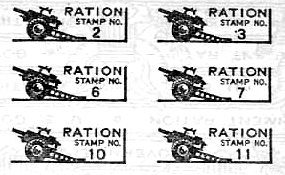
TIME SNAKES: Recollection

TIME SNAKES: Recollection
I lost the first two fingers on my left hand during World War II when I was six. We got separated playing a war game in which I was a Nazi prisoner trying to escape from a deep gully eroded in a park near our house in St. Louis. I was not alone. Our captor rained dirt down on us with a hatchet as we tried to climb to freedom. I got to the top, just as the blade of the hatchet bit into the edge of the gully I had just reached for. I wore my big, white, plaster cast like a proud battle ribbon for a few months and a few years later, the war came to a close.
To be a kid in those days was to be immersed in war games: guns, trench knives, hand-grenades--an arsenal of wound-making, gut-ripping death. We died a thousand times, riddled with each others’ deadly, mouth-tiring machine-gun fire. And we killed each other copiously, falling to rise again, falling and rising, endlessly resurrected. We spent years recreating movie battle scenes popping in and out of foxholes we dug in spacious, rolling O'Fallon Park.
But the older we got (I was eight when the war ended), the more we tired of being blown up. By 1945, we began to rechannel our military might in the direction of other, less odious enemies than Tojo, Mussolini and Hitler: our focus changed to girls.
They affected us more than we knew. In summer, we gathered and cured what we called "lady cigars", which we smoked to impress the girls and each other. These slender, almost foot-long pods hung from O'Fallon Park's many catalpa trees. We had to climb for them in the dense, deep-green canopy of almost heart-shaped leaves. Then, on one garage roof or another, we ranged the raw pods to dry on newspapers spread on the flat, sizzling tarpaper until they turned from circus-lizard green to chocolate brown.
To master this husbandry, you had to watch the drying pods as carefully
as hatching chicks or tadpoles: too much sun cracked the outer shell; the
smoke wouldn't draw; you'd have a dud. Inside their hard, brown skins,
feathery seeds encased a wrinkled, licorice-colored core resembling a starved
vanilla bean. This resinous core gave the lady cigars their kick. The seed
filler kept the husk burning like punk, igniting the core's tarry, noisome
flavor. Their acrid smoke was foul, oily, stinging. They were awful and
we loved them, as we strutted down the alleys wreathed in yellowish, fuming
clouds or slouched like hoboes as we smoked behind bushes in the park.
We did not inhale; inhaling threatened wracking, choking cough and nausea. The face turned sickly green; the stomach churned and crash-dived. We practiced blowing smoke rings and keeping our tongues from being burnt. The bravest of us smoked conspicuously at the edge of the park playgrounds, alert to counselors who'd scold us but more alert to girls who'd notice our bravado.
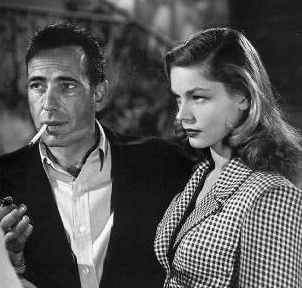 Smoking was a big deal then, especially in the movies. "Smoke 'em if you
got 'em!" was a cinematic dogface refrain when danger threatened, a line
usually intoned before servicemen mounted a landing or scrambled their
flying machines to save our bacon in a furious hail of flak. Like the native-American
calumet, shared smoke in foxhole or squad room broke tension, celebrated
survival, made men brothers. Maybe we smoked because Richard Conte dipped
his helmet a certain way to hide the flame from his Zippo. Maybe we smoked
because Ricky and Rhett smoked. Or because of how the smoke curled up Bacall's
nose before she blew out.
Smoking was a big deal then, especially in the movies. "Smoke 'em if you
got 'em!" was a cinematic dogface refrain when danger threatened, a line
usually intoned before servicemen mounted a landing or scrambled their
flying machines to save our bacon in a furious hail of flak. Like the native-American
calumet, shared smoke in foxhole or squad room broke tension, celebrated
survival, made men brothers. Maybe we smoked because Richard Conte dipped
his helmet a certain way to hide the flame from his Zippo. Maybe we smoked
because Ricky and Rhett smoked. Or because of how the smoke curled up Bacall's
nose before she blew out.
We harvested and cured many more lady cigars than we could possibly consume, as if hoarding increased our stature. This hunger to possess was one symptom of our youthful collecting mania--comic books, bottle caps, baseball cards, packs of streetcar-fare transfers, foreign coins, stamps. It almost didn't matter what; accumulating was the object of the game.
Perhaps wartime rationing honed an edge on our desire. We felt a mild itch you couldn't scratch. To buy meat, my mother had to dole out our allotment of red and blue meat tokens, dime-sized wafers punched from a hard, pressed fiberboard or use little booklets of gray-blue ration stamps for other essentials. Butter disappeared: we vied to crack the color capsule in the plastic bag of white grease that kneading turned to yellow margarine. Tobacco was rationed; so was gasoline: since factories were dedicated to turning out war materials, no cars were being made either. Tires went overseas anyway. Grown men rode bicycles.
 Since cigarettes were rationed, they were even more prized than usual.
My father often rolled his own rather than stand in a ration line, or dragooned
my bother and I to roll cigarettes in the basement on a big, red Bugler
roller. My Aunt Mabel chain-smoked Marvel, Ace, Wings--the lower-quality
wartime brands sitting in for the Camel, Chesterfield or Lucky Strike shipped
to troops.
Since cigarettes were rationed, they were even more prized than usual.
My father often rolled his own rather than stand in a ration line, or dragooned
my bother and I to roll cigarettes in the basement on a big, red Bugler
roller. My Aunt Mabel chain-smoked Marvel, Ace, Wings--the lower-quality
wartime brands sitting in for the Camel, Chesterfield or Lucky Strike shipped
to troops.
In many of our rituals, the unconscious nucleus was female. We hunted garter snakes in early summer, just after the park playgrounds opened. Each year, we mounted a snake hunt in what we dubbed "Snake Hollows"--a parcel of vacant, overgrown, insect-buzzing lots where long ago brick tenements had been demolished. This ritual involved an odd digression, one we never questioned but never truly understood.
To reach Snake Hollows, we passed by a Catholic church people called "Pink Sisters", built massively in brick, on a foundation of granite, with a high, granite wall, forbidding in its bulk, that surrounded and sheltered a three-story cloister next to the cathedral. Behind this stony separation--a world away, it seemed to us--lived an order of nuns, called variously "Pink Sisters", "Little Sisters of Poor", "Daughters of Christ" (mostly by non-Catholics I realized later), women committed to poverty and silence.
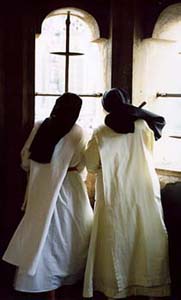 These women behind the wall fired our imaginations. We knew they had signed
up for a hard life of worship and self-sufficiency, how they never left
the convent grounds. Occasionally, we scaled their slightly inward-sloping
barrier to see what lay hidden on the other side. It felt like climbing
a prison wall, escaping. We half expected to find nuns cobbling shoes or
washing clothes in a steaming kettle. But we rarely saw a nun outdoors.
And if we spotted one from where we hung like Kilroys peering over the
crest of the wall, she turned her face away and hurried inside.
These women behind the wall fired our imaginations. We knew they had signed
up for a hard life of worship and self-sufficiency, how they never left
the convent grounds. Occasionally, we scaled their slightly inward-sloping
barrier to see what lay hidden on the other side. It felt like climbing
a prison wall, escaping. We half expected to find nuns cobbling shoes or
washing clothes in a steaming kettle. But we rarely saw a nun outdoors.
And if we spotted one from where we hung like Kilroys peering over the
crest of the wall, she turned her face away and hurried inside.
The notion of women without men intrigued us. Celibacy was not a concept we understood; but we knew these women had nothing to do with men. The war years gave us glimpses of women suddenly alone. Where fathers, sons, brothers had gone to fight stood a palpable vacuum, a space the women moved around, sighing. We saw sisters and daughters hanging clothes, carrying grocery bags or tending toddlers--standing in for working mothers. We saw the kindness women shared, the forbearance. And we saw their tears, grinding loneliness and sometimes boozy betrayals we scarcely understood. We saw rivalry too; anger, resentment; two women in a screaming, hair-tearing fight through the window of the corner tavern one night.
Girls certainly puzzled me. I never had a sister. Even the girls in Our Lady of Perpetual Help's school yard, dressed in spiffy blue and white uniforms, seemed to us inscrutable specimens of a giggling, chattering, evolving other species. Grown women we could relate to as mothers. But nuns were like creatures from outer space. Yet still they hid at the center of another ritual: we watched them. Braving discovery and reprimand, we frequently sneaked into the small cathedral to spy on the nuns at prayer. They took turns doing vigil in the wavering, candle-lit shadows behind ornate iron grills flanking the altar. To watch them, these holy women, plucked at our confusions. Certainly, it added a dimension of mystery and somehow deepened for me the enigma of woman.
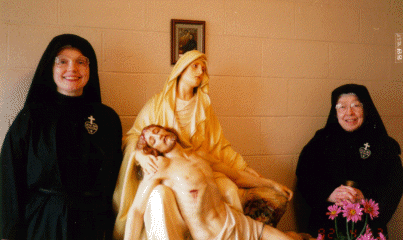 To Protestant, mostly Lutheran German kids, accustomed to a robust, no-nonsense
Gothic simplicity, the rococo, color-splashed, Catholic interior heightened
this aura of mystery. The air fumed with incense. Spears of sunlit red,
green and purple lanced down from high, peaked windows. Saints stared accusingly
from darkened niches overhead. The Blessed Virgin beckoned. The stations
of the cross shone like holy billboards advertising suffering and redemption.
Thorny, bleeding hearts abounded.
To Protestant, mostly Lutheran German kids, accustomed to a robust, no-nonsense
Gothic simplicity, the rococo, color-splashed, Catholic interior heightened
this aura of mystery. The air fumed with incense. Spears of sunlit red,
green and purple lanced down from high, peaked windows. Saints stared accusingly
from darkened niches overhead. The Blessed Virgin beckoned. The stations
of the cross shone like holy billboards advertising suffering and redemption.
Thorny, bleeding hearts abounded.
Sometimes the stony silence was torn by a plaintive chant, like softly shattering crystal, as the nuns sang in Latin. Dark and shadow were different here too: deeper, even threatening. Catholic shadows held more menace than our stark Lutheran shadows; they pulsated in the cool, shimmering gloom like moisture-laden storm clouds.
Our watching anticipated dutiful, formal worship, but this was laced with an excitement, an illicit thrill I never felt later. We strained to see through, to penetrate the garnet glimmer that banks of votive candles threw from the back of the church, where we knelt with heads half-bowed--our Catholic camouflage--to avoid discovery.
And they kept silent vigil on their knees, as unmoving as adoring statues in a crèche. These nuns, like beings disembodied, were at first simply objects of our morbid curiosity. Motionless, they seemed so otherworldly, kneeling with folded hands behind ornate iron filigree, gowned in gray-blue uniforms and pink veils under white, starched collars and hats. We waited in an answering silence, poised to detect a flicker of life--a movement of folded hands, a bowed head nodding in the sheen of altar candles. We listened for a sneeze, a cough. Sometimes, it became a breath-holding war of nerves. Like staying still to sight a rifle, to focus purely on the target. Our knees burned. How could they kneel so long without moving? Could they be wax? Were they really real?
Another question plagued us: were they really shaved bald under their ornate hats? Once, walking in a band of my buddies, I looked up to see an unhatted, unveiled nun looking down at us from the topmost window in the hulking convent’s facade. My upturned face must have flashed like a deer’s white, warning tail: instantly, she drew back and disappeared. But I saw hair, blackbird-dark, before her image faded to empty glass. And I realized with a sudden thrill that she must have been watching us.
I sensed an audacious, dangerous beauty in this awesome immobility, this life-long dedication: "brides of Christ for all eternity," I remember some adult--this one no doubt Catholic--saying. Shut up their whole life, I thought. It seemed a suicide mission, giving up such freedom, like throwing life away. We shuddered just to think of it.
At seven or eight, we were fierce for freedom, for the life teeming outside those convent walls, especially in the sweltering days and steamy, kick-the-can nights of St. Louis in summer.
Those nights held special neighborhood promises: the ting-a-ling bell of the hot tamale man's cart with its squeaky baby-carriage wheels; the Popsicle man in a policeman's hat, with his bike-driven ice box fuming with dry-ice you dared not touch; the satisfying clunk of floating ice blocks and shining melons banging the sides of Sam the Watermelon Man's big zinc tank under a fluttering canopy; the changing concentric rings of pastel water lofting and dipping in revolving, colored lights at Pevely Fountains, a drive-up dairy and ice-cream bar that families walked to in the evening because gasoline was rationed.
Days, we exercised our itch to run, to roam. Though boisterous once we clambered down the steps towards the snake hunt and left Pink Sisters behind, we went silent again as we sneaked into the Hollows, crouching like point men in a jungle. The garter snakes, we knew, could feel our footsteps.
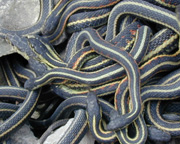
We entered their territory on tip-toe.
A rubble of stones, broken bricks and chunks of foundation granite were
overgrown with trash trees, vagrant canes and strangler vines in the uneven,
humped terrain, like a battlefield the earth had only partly digested.
It was a perfect breeding ground for snakes.
In this sanctuary, they tended to hatch under stone slabs and huddle in bunches. As we pried up stones, sun would startle the still-sluggish, knotted, little reptiles, slippery yet dry, fast as quicksilver in the sudden light. There was an instant of repose--as if time itself had hesitated--before they detonated into action. Their viper eyes belied their smooth, gracefully spiraling harmlessness as they darted in the grass to escape our eager fingers. Their spines striped white against a soft gray and dull green, they coiled in sinuous postures of the feminine, curves and loops both shy and inviting. Scales no bigger than pencil-points, they thrashed frantically but rarely bit.
We gathered them, slithering and whipping, into our shirts and walked, waiting for them to calm. A tee shirt wouldn't work, only a loose, tuck-in shirt with enough extra cloth to create a pocket, folds to hide the movement. Only a few boys carried the concealed weapons of this sweet ambush and, often, I was one. And when we were armed, we turned back towards the park's wide, greening hills and made for the playgrounds, for quarry: the girls.
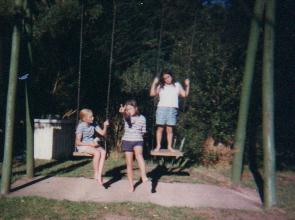
Our mission? To lure some unsuspecting
girls to the big swings. These hung on 15-foot chains, with slab seats
wide enough for one to sit and one to straddle standing up. You invited
a girl to sit and then you took her up. To "take her up" meant pairing,
a kind of courtship, in which the boy powered the swing while the girl
sat and enjoyed the ride.
The boy stood on the seat, a foot on either side of the sitting girl, who faced him. Reaching up to clasp the chains, he arched and pushed, bending to heave the combined bodies forward, slowly at first, then faster, pausing to ride the trajectory to the lip of the backswing, then surging forward again, his body flexed towards her dodging face, to rise and strain in the push and lag of each progressive pendulum arc, to lift his partner up higher and higher, the boy spread-eagled in the rushing air, the girl's hair sailing, head thrown back, knuckles white on chains.
It shook the senses: a blur of sliding perspective, a giddy swoop of shifting scene, a clenched feeling of being so close to something, so attached to the center of something, a veil of whistling pressures through which we rose and fell, trailing cries of jubilation. So strong our bent for deception, I doubt we ever considered what hovered mere inches from our partner's nose as we swooned through the hot, buzzing summer air, sweat streaming, towards some zenith.
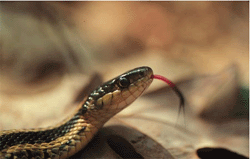
And snakes still slithering in our
shirt.
Unawakened, our fresh desire was aimed exclusively at mischief: to rise so high, to create such momentum, we took a captive and the captive could never jump off. As we humped and strained, the snakes might thrash or find their way out. And then the game would be lost. But if we reached our summit, and then, loosing one hand (supreme moment of daring) fumbled out a snake, or better yet a handful, to dangle in the screaming, now-horrified face struggling vainly for escape--that was true rite, the stuff of primitives.
For how could these girls not know, not see through our ambush, not spy snakes squirming in our shirts? Not notice our ill-disguised, wicked grins? Not cut us off at the knees before we even started the subterfuge? Of course, some did. Some were uninitiated, virgins in the side-winding strategy by which we made our first ovations to girls. But most cooperated. They screamed and giggled and played along--no different from aboriginal children, or pigmy kids we saw in scratchy Erpi classroom films, who went giggling through similar rites.
And why this hidden streak of feeling almost like revenge?
Things we sensed but did not yet know: a power girls already had over us, in our thoughts, our chip-on-the-shoulder denials, in the little dangers we rehearsed at the stage of their gaze in hopes of attracting their scant attention, the things they said behind their hands to each other, even a vague dread of their import in our futures.
For whether we stood on swings or knelt on stones, a strange continuum unfolded here: incense and candle-flame; unknown shadows suggesting unknown spaces; moist seductions of heart and hidden body; the iron focus of those kneeling forms, the whistling air and breath-taking motion...These intimations swirled for us like smoke or shadows through which we could not see.
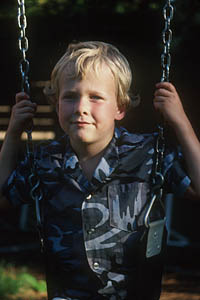 And
finally, as we outgrew our weaponry, exchanged trench-knives and rifles
for hockey sticks and baseball bats, we began to see these whispering,
squealing creatures in a different light. That summer, one of our gang
began to comb his hair before we hit the playgrounds and we all aped his
combing vanity in louche exaggeration, making wet kissing sounds on our
bare arms. But under the lid of our self-conscious hilarity, the first
siren strains of a coming urgency sounded and--as the cobra rises from
the basket--sex lifted sleepy eyes and spread its hood.
And
finally, as we outgrew our weaponry, exchanged trench-knives and rifles
for hockey sticks and baseball bats, we began to see these whispering,
squealing creatures in a different light. That summer, one of our gang
began to comb his hair before we hit the playgrounds and we all aped his
combing vanity in louche exaggeration, making wet kissing sounds on our
bare arms. But under the lid of our self-conscious hilarity, the first
siren strains of a coming urgency sounded and--as the cobra rises from
the basket--sex lifted sleepy eyes and spread its hood.
While we talked and joked about it, real sex for us at eight or nine was unknown territory, except for movies and tales--or boasts--of older brothers or school yard clinicians, passed down through many editions, as in the game of "telephone."
At school, precociously endowed Wanda-Lee could sometimes be spied mixing it up with a boy in the cloakroom, once with his hand way up her dress. When I was maybe ten, another coming attraction, a cute, blonde girl named LaRee, sat on my stomach one steamy summer Saturday morning and dripped melting grape Kool-Ade ice cubes onto my bare chest, squirming and laughing as her tickling, insistent fingers spread around the sugary stickiness.
We had elaborate class room schemes, involving little pocket mirrors we stole from Woolworth's or Rexall's, for catching a look up girls' dresses. We dropped a pencil as one walked by, or pushed a book off the desk, then feverishly reached down a mirror-clutching hand, trying to aim its tiny focus up her skirt to reflect her pants (or, our fervent hope, lack of pants). This actually worked about as well as trying to hit a frantic bird in a barn with a slingshot. Lottery odds. But how we tried.
Movie sex was tame in those days. At carnal moments, the camera panned to blowing curtain or guttering candle flame. In fact, things were usually hotter in neckers' paradise, the last two rows of seats at the O'Fallon theater, than up on the screen.
Another feat of deering-do was to entice uninitiated girls at the movie up to what was called "the cry room". This picture-window, soundproof room upstairs by the ladies restroom contained five theater seats and a speaker to play the movie soundtrack. Here, mothers with bawling babies could watch the movie without disturbing the whole theater.
Women without men regularly went to
the movies alone and brought their babies along, especially on "Dish Night"
when they could win free kitchen crockery as door prizes. The cry room
was not always in use, however, and to sneak a girl past the gimlet-eyed
manager by the popcorn machine for a little back-row action upstairs was
a feat of steely risk and raw courage. What bumbling, romantic moves we
could inflict on the hapless girl were less important than running a gantlet
of possible menaces: mothers, older guys with the same idea, the manager
and the lone, one-eyed usher who we all joked had already been embalmed
at nearby Math-Hermann funeral parlor.
 Pornography in the 1940s was hardly even a word. Girlie magazines beckoned
in barbershops. A burlesque show downtown--and its adjacent peep-show parlor--we
discovered much later in life. At Royce's Pipe Shop, an older kid packed
a deck of cards with 52 naked ladies flashing bare breasts but coyly covering
the other good stuff, which he let us glimpse behind the counter. The two
"jokers" were women with men's genitals superimposed, a shocker to curious
kids!
Pornography in the 1940s was hardly even a word. Girlie magazines beckoned
in barbershops. A burlesque show downtown--and its adjacent peep-show parlor--we
discovered much later in life. At Royce's Pipe Shop, an older kid packed
a deck of cards with 52 naked ladies flashing bare breasts but coyly covering
the other good stuff, which he let us glimpse behind the counter. The two
"jokers" were women with men's genitals superimposed, a shocker to curious
kids!
We made crude drawings of people "doing it". Once, on our rambles in the park, we came upon a man and woman doing it with great gusto behind bushes, and stood transfixed. And then we discovered, quite by accident, a treasure trove of clever carnality that marked indelibly our notions of what lay ahead: the eight-page bibles.
We found them ash-pit hunting. There must have been 20, wrapped like a brick in newspaper with fussy, many-knotted neatness in one of the ash-pits. Ash-pits were not pits at all, but brick or concrete-block enclosures five to six feet high between garages on the alley. There, homeowners threw ashes, clinkers, bottles, cans and any other trash that wasn't garbage, to be emptied by trucks from the alley. We scavenged them regularly for useful trash and weird souvenirs. The eight-page bibles were a major strike.
These midget comic books, cartoon line
drawings in black and white, were only a little larger than a baseball
trading card. They were normally eight pages, on rough, pulp paper, with
single pages sometimes divided into two smaller panels. We had never heard
of them. Only later did we learn they were called "eight-page bibles".
For as we broke open the tight, little bundle and fumbled out the contents,
we found old friends--our Sunday morning buddies--doing the most amazing,
nasty things to each other.
Here were familiar funny-paper characters--drawn with satisfying authenticity--Dick Tracey and Tess, Jiggs and Maggie, Dagwood and Blondie (and the kids!), Nancy and Sluggo, L'il Abner and Daisy Mae, even the Katzenjammer Kids--all wound up, connected, linked in wondrously smutty, carnal combat. We were dumbfounded, delighted, perplexed, skeptical to see such things were done in such a way. We hardly had names for what we were seeing.
Taboos tumbled before our incredulous eyes: not only did Dagwood do it to Blondie, his signature cowlick erect and drops of sweat springing off his head, but Alexander did it to Cookie--and then they switched! Forward, backward, upside down. In the end, a ravening, still unsated Dagwood eyed the cringing dog, Daisy, lasciviously as a bushed but maniacal Blondie urged him on.
 Cap in hand, Sluggo took the now-bubble-breasted Nancy doggie style, as
scraggly Jiggs, still top-hatted and champing his cigar, mounted Maggie
like a grinning bulldog and puffed great clouds of smoke and salacious
celebration. And here was Mickey doing what mice normally do to Minnie,
and spinach-gobbling Popeye and bullying Bluto tussling over turns with
unruffled, oddly pneumatic Olive Oyl. All the bodies were similarly drawn,
but with the authentic-looking cartoon heads superimposed.
Cap in hand, Sluggo took the now-bubble-breasted Nancy doggie style, as
scraggly Jiggs, still top-hatted and champing his cigar, mounted Maggie
like a grinning bulldog and puffed great clouds of smoke and salacious
celebration. And here was Mickey doing what mice normally do to Minnie,
and spinach-gobbling Popeye and bullying Bluto tussling over turns with
unruffled, oddly pneumatic Olive Oyl. All the bodies were similarly drawn,
but with the authentic-looking cartoon heads superimposed.
Each little tome we devoured uproariously yet with trembling hands. This smut inspired a kind of reverence, produced a weird body tightness, awakened a higher caliber of fantasy to see such slick and slurpy permutations and combinations we scarcely imagined and would not see again until R. Crumb took up his pen in the hippie '60s to revive this cartoon art form with nonchalant hilarity. Who was this clever pornographer, 30 years previous, scandalizing the Sunday morning funny-paper crowd? We never found out.
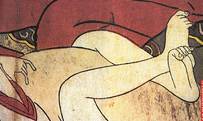 Years later, I remembered our crude discoveries when writing an article
on Japan's cartoon pornography--men hauling their own huge phalli on wheelbarrows
or giant members carried by bearers in pomp and splendor, like Sudan-chair
royalty. Simple ink drawings on Manila paper had the texture of that rough,
wartime pulp. And a flash of memory for feelings: the humor, the funny-paper
familiarity, the cartoon format that smoothed a disturbing edge off what
we sat there taking in.
Years later, I remembered our crude discoveries when writing an article
on Japan's cartoon pornography--men hauling their own huge phalli on wheelbarrows
or giant members carried by bearers in pomp and splendor, like Sudan-chair
royalty. Simple ink drawings on Manila paper had the texture of that rough,
wartime pulp. And a flash of memory for feelings: the humor, the funny-paper
familiarity, the cartoon format that smoothed a disturbing edge off what
we sat there taking in.
We hid away an entire, summer Saturday afternoon in a cavernous, dark shed by the alley, processing and savoring those stunted pages by chinks of sunlight, filling our heads with burning questions, vague alarms, secret runes that softly abraded childhood innocence. With vows of secrecy, we reverently rewrapped and hid them, reconvening the next day--Sunday--to sit cross-legged in furious concentration, poring over the little booklets and smoking lady cigars until we were sick. Each time, we retied and rehid our precious bundle behind boards in the barn-like shed on the alley behind Kenny McClain's house.
But the story of our sex-book serendipity must have spread beyond our circle. A few days later, the bundle was gone. We kept our ears open and our senses sharp to discover who could have raided our cache. We conducted a mini-inquisition too, surrounded by burning candles, pledging no reprisals even if one of our select band had betrayed us. Our treasure never resurfaced.
But seeds had been planted. We never
read the Sunday funnies again without dissolving into uncontrolled fits
of laughter, which puzzled our parents and siblings no end. And even now,
when I happen across any of the old characters (now mostly gone except
for Nancy and Blondie) in the newspapers, they occasionally threaten to
tear off their clothes and have at each other, reveling once more in secret
passions and forbidden lusts.
© S. K. Oberbeck 1999 Top
Please do not quote or use material
without copyright attribution.